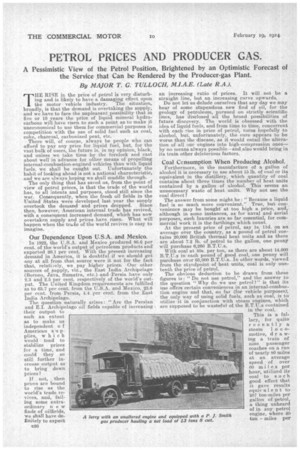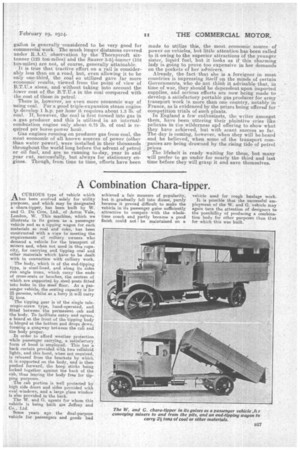PETROL PRICES AND PRODUCER GAS.
Page 10

Page 11

If you've noticed an error in this article please click here to report it so we can fix it.
A Pessimistic View of the Petrol Position, Brightened by an Optimistic Forecast of the Service that Can be Rendered by the Producer-gas Plant.
By MAJOR T. G. TULLOCH, (Late R.A.).
THE RISE in the price of petrol is very disturbing and is likely to have a damaging effect upon the motor vehicle industry. The situation, broadly, is that the demand is overtaking the supply, and we have to face the unpleasant possibility that in five or 10 years the price of liquid mineral hydrocarbons will have risen to such a point as to make it uneconomical to use them for commercial purposes in competition with the use of solid fuel such as coal, coke, charcoal, carbonized peat, etc.
There will, of course, always be people who can afford to pay any price for liquid fuel, but, for the vast bulk of users, the future is, in my opinion, black, and unless we take time by the forelock and east about well in advance for other means of propelling internal-combustion-engined vehicles than with liquid fuels, we shall be caught out. Unfortunately the habit of looking ahead is not a national characteristic, and we are always hoping we shall muddle through.
The only thing that has saved us, from the point of view of petrol prices, is that the trade of the world has, to all intents and purposes, stood still since the war. Consequently, when the fresh oil fields in the -United States were developed last year the supply overtook the denim/n(1 • and prices dropped. Since then however, American internal trade has revived, with 'a consequent increased demand, which has now overtaken supply and prices have risen. What will happen when the tra.ge of the world revives is easy to imagine.
Our Dependence Upon U.S.A. and Mexico.
In 1922, the U.S.A. and Mexico produced 86.6 per cent. of the world's output of petroleum products and exported 20.1 per cent. With the present increasing demand in America, it is doubtful if we should get any at all from that. source were it not for the fact that, relatiJely, wepay highey prices. Our .other sources of supply, viz., the East India Archipelago (Borneo, Java, Sumatra, etc.) and Persia have only 2.3 and 2.5 per cent, respectively of the world's output. The United Kingdom requirements are fulfilled as to 63.7 per cent. from the U.S.A. and Mexico, 23.6 per cent. from Persia, 4.4 per cent, from the East India Archipelago.
If net, then prices are bound to rise as the world's trade revives, and, failing some extraordinary n e w finds of oilfields, we shall have defanitely to expect e26 an increasing ratio of prices. It will not be a straight line, but an increasing curve upwards. Do not let us delude ourselves that any day we may hear of some stupendous new find of oil, for the geology of petroleum, pursued on strictly scientific hues, has disclosed all the broad possibilities of future discovery.. The world is obsessed with the idea of liquid fuels, and from time to time, concurrent with each rise in price of petrol, turns hopefully to alcohol, but, unfortunately,_ the cure appears to be worse than the disease, as it would entail the alteration of all our engines into high-compression ones— by no means always possible—and also would bring in its train other deleterious factors.
Coal Ccnsumption When Producing Alcohol.
Furthermore, in the manufacture of a gallon of alcohol it is necessary to use about 15 lb. of coal or ite equivalent in the distillery, which quantity of coal contains about three times the number of heat units contained by a gallon of alcohol. This seems an unnecessary waste of heat units. Why not use the coal direct ?
The answer from some might be : "Because a liquid fuel is so much more convenient." True, but convenience may be bought at too high a price, and, although in some instances, as for naval and aerial purposes, such luxuries are so far essential, for commercial work it is the farthings which count. At the present price of petrol, say Is. lid, on an average over the country, as a pound of petrol contains 20,000 British thermal heat units and as there are about 7.2 lb. of petrol to the gallon, one penny will purchase 6,260 B.T.U.s. With coal at 40s. per ton, as there are about 14,000 B.T.U.s in each pound of good coal, one penny will purchase over 65,000 B.T.U.s. In other words, viewed from the standpoint of heat units, coal is only onetenth the price of petrol. The obvious deduction to be drawn from these figures is : "Do not use petrol," and the answer to the question "Why do we use petrol ?" is that its use offers certain conveniences in an internal-combustion engine and that, so far (for vehicle purposes), the only way of using solid fuels, such as coal, is to utilize it in conjunction with steam engines, which are supposed to be wasteful of the B.T.U.s contained in the coal.
This is a fallacy, for quite recently a
steana 1 o c omotive, d r a wing a train of nine passenger coaches on a run of nearly 80 miles at an average speed of over 60 na i 1 e.s per hour, utilized its coal to such good effect that it gave results equivalent to 287 ton-miles per gallon of petrol, a thing unheard of in any petrol engine, where 40 ton miles per gallon is generally -considered to be very good for commercial work. The much longer distances covered under R.A.C. observation by the Thornycroft sixtanner (123 ton-miles) and the Saurer 5-5-tonner (104 ton-miles) are not, of course, generally attainable.
It is true that tractive effort on a rail is considerably less than on a road, but, even allowing it to be only one-third, the coal so utilized gave far more economic results, viewed from the point of view of B.T.U.s alone, and without taking into account the lower cost of the B.T.U.s in the coal compared with the cost of these in petrol.
There is, however, an even more economic way of using coal. For a good triple-expansion steam engine to develop 1 h.p. per hour it requires about 1.3 lb. of coal. Ti, however, the coal is first turned into gas in a gas producer and this is utilized in an internalcombustion engine only about 0.75 lb. of coal i6 required per horse-power both..
Gas engines running on producer gas from coal, the most economic of all known sources of power (other than water power), were installed in their thousands throughout the world long before the advent of petrol or oil fuel, and are so running to-day, year in and year cut, successfully, but always for stationary engines. Though, horn time to time, efforts have been made to utilize this, the most economic source of power on vehicles, but little attention has been called to it owing to the superior attractions of the younger sister, liquid fuel, but it looks as if this charming i lady s going to prove too expensive in her demands on the pockets of her admirers.
Already, the fact -that she is a foreigner in most countries is impressing itself on the minds of certain Governments, who do not think it advisable that, 'in time of war, they should be dependent upon imported supplies, arid serious efforts are now being made to develop a satisfactory portable gas producer for army transport work in more than one country, notably in France, as is evidenced by the prizes being offered for competition trials of such plants.
In England a few enthusiasts, the writer amongst them, have been uttering their plaintive cries like pelicans in the wilderness and offering to show what they have achieved, but with scant success so far. The day is coming, however, when they will be heard and be believed, when some of the transport corn'panies are being drowned by the rising tide of petrol prices The lifebeit is ready waiting for them, but many will prefer to go under for nearly the third and last time before they will grasp it and save themselves.
































